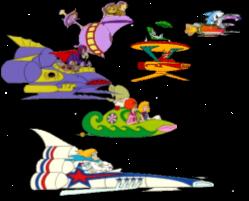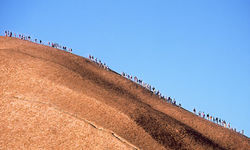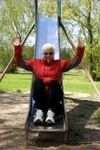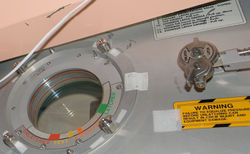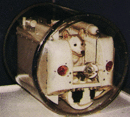Space Race
The Space Race is a race between The United States of America and the USSR. The two contenders have to build rockets to launch their countries from the surface of the Earth to land on the Moon. Rockets are generally placed in holes drilled deep into the ground, while specalized teams work at seperating the crust from the mantle.
Origins[edit | edit source]
The space race began after Yuri Gregremlin orbited the earth in his Vokswagen spacecraft, winning the race into space. Not to be outdone, the americans declared the race was about to begin (when they were ready) (and preferably with a headstart) (can we start again) ??
Early attempts by american engineers involved jumping as high as they could. This was met with great success, but also criticism from the scientific community. NASA cited costs were an issue with this approach, and a cheaper safer system should be developed. Improved attempts involved $500 sofas, $4,000 chairs, $45,000 ladders and lots of broken legs. In the late 50's the Amplesteam commission recommended to congress an international program of co-operation with people who had a clue. Chinese officials offered support when they finally stopped laughing. The first person to be second best in the space program, Alan Shepard, was selected by the chinese after a thorough physical examination. Special attention was payed to his ass, and the reasoning was later revealed upon the new testfirings. $519,000 of NASA approved and funded Chinese-built fireworks were inserted into the astronauts rectum in preparation for launch, scheduled for October 1960. Technical difficulties on the launchpad began a tradition of NASA delays and rescheduling. Official investigations found shedding of incendiary material due to vibratory acceleration caused by spasming of the launch vehicle Sheppard, due to, as an unnamed advisory committee member stated 'he couldn't stop laughing, every time he laughed, some popped out'. Delays continued until may 1961 when a methyl alcohol concentration of 3% was found to stabilize the launch vehicle.
After last minute preparations and checks that no further propulsion material could be added to the launcher, Alan Shepard was blasted to a height of over 100ft according to witnesses. 'It was a sight I will never forget to my dying day, there are simply no words to describe this unparalleled spectacle, truly epic', 'The blast was incredible, the loudest thing I ever heard, I think the guy next to me was hit with some very small peices, there was a lot of smoke, it was unbelieveable'. NASA with the help of fox news reported to the american public that Alan Shepard had reached an altitude of 100 miles. The Whitehouse is speculated to have received a classified report stating that no bigger ASS or more accommodating asshole could be found, and further searching was unlikely to meet with success, prompting the Whitehouse's decision to declare 100 miles to be the new height of space. Conventional scientific consensus contrary to the white house position, otherwise known as terrorism, defines space flight as breaking free of earths gravity, called orbiting, rather than parabolic trajectories that cause an object to return to the ground by itself. see also slingshot powered hamsters, budgie badminton and turtle hockey.
Alan Shepard went on from his humble beginnings of being the first person to be second in space, with NASA's continuing help he became the 5th person to be first on the Moon.
Space Tourism (Spin-off industry)[edit | edit source]
Space tourism comes in two types, Orbital and Sub-Orbital. Sub-Orbital is a direct spin-off from American discoveries regarding the height of space. Whilst Orbital Space Tourism involves holidaying on the International Space Station, and getting there by Soyuz Rockets, it is much more expensive than real people can afford, and is only for seriously rich people and NASA astronauts, (now that 40% of the shuttle fleet has exploded, and the rest have fallen to pieces). Sub-Orbital Space Tourism by contrast is economical, depending on the country of departure. In Outback Australia, thanks to the local aboriginal tribal elders declaration of space beginning at 100 feet, tourists can take a 20 minute climb into space on Uluru. Closer to home, Americans can enjoy a refreshing sojourn into space in Lancaster County, Pennsylvania, where the local Amish-dominated authorities declare anything over 10 feet from the ground to be in the heavens.
Hazards[edit | edit source]
Unfortunately, due to lack of oxygen in open space, every time an American goes out to look at the View from the International Space Station, the station is depressurized, Russian officials have affixed warning labels to the United States section of the station, to reduce the frequency of this inconvenience.
Early Lunar Attempts[edit | edit source]
After several unsuccessful attempts through the use of rocket propelled catapults, the USSR realized that they might have more success if they aimed their unmanned shuttles at space and not West Berlin. On July the 15th In 1952 Nikola Khrushchev set the USSR it's most ambitious space project yet. It was announced several days later that a series of rockets were to be launched at the moon to misalign it's orbit by 3 degrees. The plan was made to help Khrushchev overcome his fear of the Moon. Unfortunately though, the USSR didn't possess the technology to send an unmanned shuttle to the moon. To correct this problem a trained dog called Spunicruskev, or "inferior bladdered one" in English, was placed in the capsule to help pilot the spaceship. The Mission ended in tragedy when Spunicruskev exploded from what was later revealed to be a swollen bladder. The USSR conceded this was a poor decision and on the next mission a Mexican bladderless snapping turtle was sent.
The Race to Mars[edit | edit source]
America is well positioned to win the race to Mars, thanks to the Brilliant strategy of President Bush and NASA. Whilst The Russian, Chinese and European Space agencies co-operate in the Mars 500 project, to compliment their Rocket-building programs, America has discovered several short-cuts to Mars.
The American President George W. Bush stated "Lifting heavy spacecraft and fuel out of the Earth's gravity is expensive. Spacecraft assembled and provisioned on the moon could escape its far lower gravity using far less energy, and thus, far less cost." You can ask everyones favorite drive by shooter, google, they'll tell you the same thing. To make sure people didn't think this was another one of Bush's stoned rants, NASA's chief repeated the same thing 48 hours later. Clearly the USA has cheated by signing secret agreements with the Moons native inhabitants to provide Labor cheaper than Americans, and the Moon's favorable exchange rate makes the purchase of hardware from local stores more attractive.
Other initiatives include pretending they are not in a race, NASA Chief Sean O'Keefe has repeatedly stated “NASA should not be destination-driven”, then tricking other nations into carrying an American to Mars, and taking credit for the whole project. Like the International Space Station, a Russian station, with passive modules from many countries attached to it, allowing those countries to take credit for the whole station.
